Themed collection JMC C Top Picks collection: Recent progress in light emitting diodes

Fluorescent nanomaterial-derived white light-emitting diodes: what's going on
In this review, we highlight recent progress of fluorescent nanomaterial-derived white LEDs, including semiconductor nanocrystals or colloidal QD-based LEDs, carbon-based LEDs, silicon QD-based LEDs, and organic–inorganic fluorescent nanocomposite derived white LEDs.
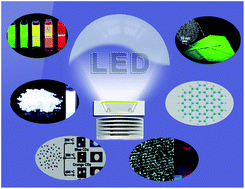
J. Mater. Chem. C, 2014,2, 4358-4373
https://doi.org/10.1039/C4TC00048J
Approaches for fabricating high efficiency organic light emitting diodes
Highly efficient OLEDs are extremely demanded for the design of highly competitive energy-saving displays and lightings. In this article, we have systematically reviewed some most effective organic materials, eleven device architectural approaches, and outcoupling techniques to realize the high efficiency OLEDs.
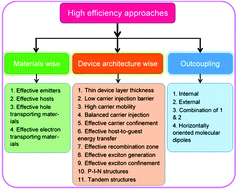
J. Mater. Chem. C, 2015,3, 2974-3002
https://doi.org/10.1039/C4TC02495H
Recent advances of the emitters for high performance deep-blue organic light-emitting diodes
Recent advances in deep-blue emitters furnishing high performance OLEDs and associated critical issues are discussed and reviewed.
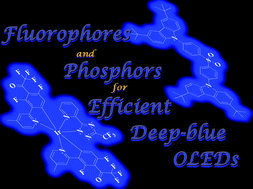
J. Mater. Chem. C, 2015,3, 913-944
https://doi.org/10.1039/C4TC02474E
A low-temperature co-precipitation approach to synthesize fluoride phosphors K2MF6:Mn4+ (M = Ge, Si) for white LED applications
A new class of Mn4+ activated alkali-metal hexafluoride red phosphors are emerging for white light-emitting diodes because of their sharp red line 2Eg → 4A2g emissions (600–650 nm) excited by irradiation of 4A2g → 4T1g (320–380 nm) and 4A2g → 4T2g (380–500 nm) transitions.
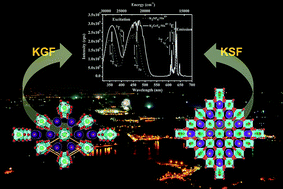
J. Mater. Chem. C, 2015,3, 1655-1660
https://doi.org/10.1039/C4TC02551B
Synthesis of Na2SiF6:Mn4+ red phosphors for white LED applications by co-precipitation
A one-step approach to synthesize Na2SiF6:Mn4+and K2SiF6:Mn4+ red phosphors by co-precipitation is reported in this paper.
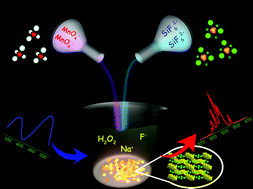
J. Mater. Chem. C, 2014,2, 10268-10272
https://doi.org/10.1039/C4TC02062F
The formation mechanism, improved photoluminescence and LED applications of red phosphor K2SiF6:Mn4+
The formation mechanism of red phosphor K2SiF6:Mn4+ free of manganese oxides has been discussed based on detailed experimental results. Significant improvements in the luminescence efficiency make it a good candidate for applications in “warm” white LEDs.
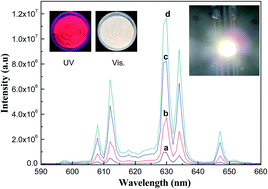
J. Mater. Chem. C, 2014,2, 3879-3884
https://doi.org/10.1039/C4TC00087K
Deep blue fluorophores incorporating sulfone-locked triphenylamine: the key for highly efficient fluorescence–phosphorescence hybrid white OLEDs with simplified structure
Deep blue fluorophors incorporating sulfone-locked triphenylamine were developed for hybrid white OLEDs.

J. Mater. Chem. C, 2015,3, 6986-6996
https://doi.org/10.1039/C5TC01373A
Luminescence study of a self-activated and rare earth activated Sr3La(VO4)3 phosphor potentially applicable in W-LEDs
A novel self-activated and rare earth activated Sr3La(VO4)3 phosphor is potentially applicable in near UV excited W-LEDs.
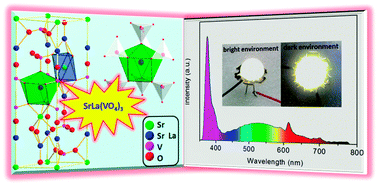
J. Mater. Chem. C, 2015,3, 3023-3028
https://doi.org/10.1039/C4TC02783C
Controlled emission colors and singlet–triplet energy gaps of dihydrophenazine-based thermally activated delayed fluorescence emitters
We have developed thermally activated delayed fluorescence emitters with wide ranges of emission colors and singlet–triplet energy gaps.
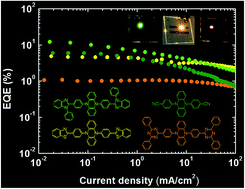
J. Mater. Chem. C, 2015,3, 2175-2181
https://doi.org/10.1039/C4TC02530J
A solution-processable host material of 1,3-bis{3-[3-(9-carbazolyl)phenyl]-9-carbazolyl}benzene and its application in organic light-emitting diodes employing thermally activated delayed fluorescence
The stability of solution-processed organic light-emitting diodes employing a thermally activated delayed fluorescent emitter was improved using a host with a high glass transition temperature and high mobility electron transport layers.
![Graphical abstract: A solution-processable host material of 1,3-bis{3-[3-(9-carbazolyl)phenyl]-9-carbazolyl}benzene and its application in organic light-emitting diodes employing thermally activated delayed fluorescence](/en/Image/Get?imageInfo.ImageType=GA&imageInfo.ImageIdentifier.ManuscriptID=C4TC02211D&imageInfo.ImageIdentifier.Year=2015)
J. Mater. Chem. C, 2015,3, 1700-1706
https://doi.org/10.1039/C4TC02211D
A high triplet energy, high thermal stability oxadiazole derivative as the electron transporter for highly efficient red, green and blue phosphorescent OLEDs
A high glass transition, triplet energy gap and electron mobility material, TPOTP, is readily synthesized. It can serve as an efficient universal electron transporter and exciton blocker for blue, green and red phosphorescent OLEDs.
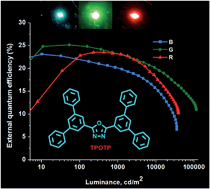
J. Mater. Chem. C, 2015,3, 1491-1496
https://doi.org/10.1039/C4TC02348J
Phosphine oxide functionalized pyrenes as efficient blue light emitting multifunctional materials for organic light emitting diodes
Efficient electron transporting blue emitting materials obtained from excimer emission assisted by thermally activated delayed fluorescence.
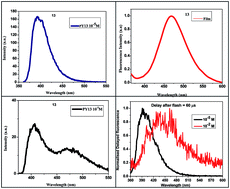
J. Mater. Chem. C, 2015,3, 1208-1224
https://doi.org/10.1039/C4TC01753F
Starburst 4,4′,4′′-tris(carbazol-9-yl)-triphenylamine-based deep-blue fluorescent emitters with tunable oligophenyl length for solution-processed undoped organic light-emitting diodes
Starburst TCTA-based deep-blue emitters are developed, whose solution-processed undoped device performance increases gradually with increasing oligophenyl length.
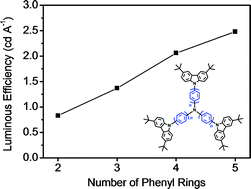
J. Mater. Chem. C, 2015,3, 861-869
https://doi.org/10.1039/C4TC02173H
Synthesis of narrow-band red-emitting K2SiF6:Mn4+ phosphors for a deep red monochromatic LED and ultrahigh color quality warm-white LEDs
In this study, we synthesized and characterized narrow-band red-emitting K2SiF6:Mn4+ phosphors in order to improve the color qualities of warm white light-emitting diodes (LEDs).
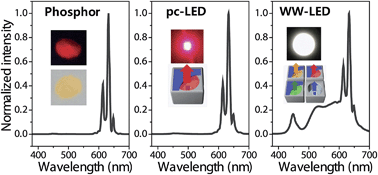
J. Mater. Chem. C, 2015,3, 607-615
https://doi.org/10.1039/C4TC02042A
Synthesis, structure and optical properties of cerium-doped calcium barium phosphate – a novel blue-green phosphor for solid-state lighting
A new blue-green phosphor, Ca6BaP4O17:Ce3+, which can be prepared by conventional solid-state synthesis, is reported as a candidate phosphor for solid-state lighting with near-ultraviolet LEDs.
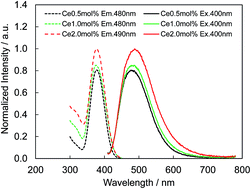
J. Mater. Chem. C, 2015,3, 204-210
https://doi.org/10.1039/C4TC01835D
Correlating the transition dipole moment orientation of phosphorescent emitter molecules in OLEDs with basic material properties
The orientation of seven iridium-based emitter molecules for OLEDs is compared and surprisingly all except Ir(ppy)3 show considerable horizontal orientation.
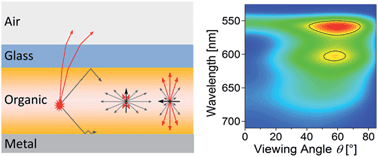
J. Mater. Chem. C, 2014,2, 10298-10304
https://doi.org/10.1039/C4TC00997E
Offsetting the problem of charge trapping in white polymer light-emitting diodes using a fluorenone-based luminogen
AA Fluorenone-based AIEE luminogen is used a covalent dopant to design a white light emitting copolymer with minimized charge trapping.
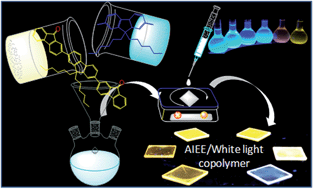
J. Mater. Chem. C, 2014,2, 9035-9044
https://doi.org/10.1039/C4TC01722F
Highly efficient and color-stable hybrid warm white organic light-emitting diodes using a blue material with thermally activated delayed fluorescence
A blue fluorophor with thermally activated delayed fluorescence is firstly introduced in hybrid WOLEDs to reduce the triplet loss.
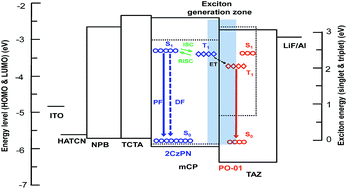
J. Mater. Chem. C, 2014,2, 8191-8197
https://doi.org/10.1039/C4TC01289E
9,9′-Spirobifluorene and 4-phenyl-9,9′-spirobifluorene: pure hydrocarbon small molecules as hosts for efficient green and blue PhOLEDs
This work reports the use of 9,9′-spirobifluorene and 4-phenyl-9,9′-spirobifluorene, pure hydrocarbon small molecules, as hosts for efficient green and blue phosphorescent OLEDs.

J. Mater. Chem. C, 2014,2, 4156-4166
https://doi.org/10.1039/C4TC00171K
Platinum(II) complexes with cyclometallated 5-π-delocalized-donor-1,3-di(2-pyridyl)benzene ligands as efficient phosphors for NIR-OLEDs
PtL2Cl (HL2 = 5-(p-(NPh2)styryl-1,3-di(2-pyridyl)benzene) emerges as an excellent candidate for the preparation of NIR-OLEDs.
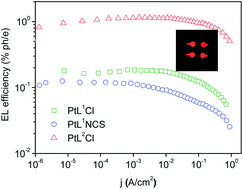
J. Mater. Chem. C, 2014,2, 1791-1800
https://doi.org/10.1039/C3TC32086C
About this collection
This second in a series of JMC C Top Picks web collections highlights some of the best research in organic and inorganic light emitting diodes.
Journal of Materials Chemistry C’s Associate Editor, Professor Malika Jeffries-El (Boston University), invites you to view reviews and original research demonstrating recent advances in the development of high-efficiency organic and inorganic light emitting diodes (OLEDs and LEDs) that feature red, blue, green, white and near-IR emissions.
Discover novel design and synthetic strategies which have yielded organic materials for use as wide band gap hosts and deep blue emitters, and the use of thermally activated delayed fluorescence resulting in significant improvements in the performance of OLEDs. Also find out how novel phosphorescent inorganic materials have enabled a paradigm shift from simple LEDs to advancements in the development of solid-state lighting.